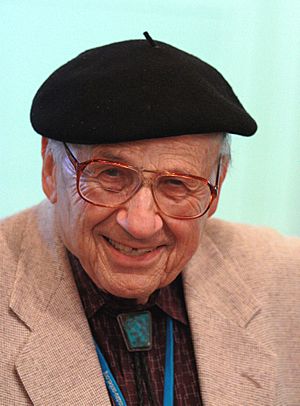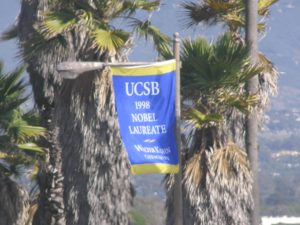Walter Kohn facts for kids
Quick facts for kids
Walter Kohn
|
|
|---|---|

Kohn in 2012
|
|
| Born | March 9, 1923 Vienna, Austria
|
| Died | April 19, 2016 (aged 93) |
| Nationality | American |
| Alma mater | University of Toronto, Harvard |
| Known for | Density functional theory Luttinger-Kohn model Hohenberg-Kohn theorems Kohn-Sham equations KKR method Kohn anomaly Kohn effect |
| Spouse(s) | Lois (Adams) Mara (Vishniac) Schiff |
| Awards | Oliver E. Buckley Condensed Matter Prize (1961) National Medal of Science (1988) Nobel Prize in Chemistry (1998) |
| Scientific career | |
| Fields | Physics, Chemistry |
| Institutions | Carnegie Mellon University, UC Santa Barbara, UC San Diego |
| Doctoral advisor | Julian Schwinger |
| Doctoral students | Lu Shem |
| Signature | |
 |
|

Walter Kohn (born March 9, 1923 – died April 19, 2016) was a brilliant scientist from Austria and America. He was a theoretical physicist and theoretical chemist.
In 1998, he won the Nobel Prize in Chemistry with another scientist, John Pople. They won for helping us understand how electrons behave in materials. Kohn was especially important for developing something called density functional theory. This theory made it much easier to calculate how electrons work in different materials. It became a very important tool in science.
Contents
Early Life and Moving to Canada
Walter Kohn was from a Jewish family in Vienna, Austria. When Adolf Hitler's government took over Austria, Walter had to leave. He was part of the Kindertransport, a rescue operation that brought many Jewish children to safety in England.
Sadly, his parents and many relatives were killed during the Holocaust. Walter later said he believed in Deism, a belief that God created the universe but does not interfere with it.
When World War II started, Walter was an Austrian national in England. Because of this, he was sent to Canada in July 1940. He was only 17 years old. He traveled across the ocean in a British convoy, avoiding German submarines.
In Canada, he was held in camps at first. But these camps had some educational facilities. Walter used them to study hard and eventually got into the University of Toronto. As a German national, he wasn't allowed into the chemistry building, so he chose to study physics and mathematics instead.
Walter Kohn's Scientific Journey
Walter Kohn finished his bachelor's degree in applied mathematics at the University of Toronto in 1945. He earned his master's degree there in 1946. Then, he went to Harvard University and received his Ph.D. in physics in 1948. At Harvard, he learned a lot about solid-state physics, which studies how materials behave.
From 1950 to 1960, he worked at Carnegie Mellon University. Here, he did important work on how electrons move in materials, which led to the KKR method. He also worked with Bell Labs and collaborated with Joaquin Mazdak Luttinger. Together, they developed the Luttinger-Kohn model, which helps explain how semiconductors work.
In 1960, he moved to the new University of California, San Diego. He stayed there until 1979. During this time, he and his student Chanchal Kumar Majumdar developed the Kohn–Majumdar theorem. Later, he became the founding director of the Institute for Theoretical Physics in Santa Barbara. In 1984, he became a professor at the University of California at Santa Barbara, where he worked for the rest of his life.
Walter Kohn's work on semiconductor physics was very important. It earned him the Oliver E. Buckley Prize from the American Physical Society. He also received the Feenburg medal for his work on the many-body problem, which deals with how many particles interact.
His most famous work, density functional theory, started when he visited Paris. He worked with Pierre Hohenberg on the Hohenberg–Kohn theorem. Later, with his student Lu Jeu Sham, they developed the Kohn–Sham equations. These equations are now a standard tool in modern materials science and even in understanding plasmas.
In 1957, Walter Kohn became a citizen of the United States. He was also a member of many important scientific groups, including the American Academy of Arts and Sciences and the National Academy of Sciences. In 2011, he became an honorary member of the Austrian Academy of Sciences.
Later Years and Passing
Walter Kohn passed away on April 19, 2016, at his home in Santa Barbara, California. He was 93 years old and died from jaw cancer.
Awards and Honors
Walter Kohn received many awards for his amazing contributions to science:
- Oliver E. Buckley prize in Solid State Physics (American Physical Society, 1961)
- Davisson-Germer Prize (American Physical Society, 1977)
- National Medal of Science (1988)
- Nobel Prize in Chemistry (1998)
- Elected a Foreign Member of the Royal Society (1998)
- Austrian Decoration for Science and Art (1999)
- Grand Decoration of Honour in Silver with Star for Services to the Republic of Austria (2008)
- Harvard University awarded him an Honorary Doctor of Science (May 2012)
Images for kids
-
Walter Kohn receiving an honorary doctorate at The University of Oxford.
See also
 In Spanish: Walter Kohn para niños
In Spanish: Walter Kohn para niños
- List of Jewish Nobel laureates
- List of Nobel laureates affiliated with the University of California, Santa Barbara
- List of refugees


